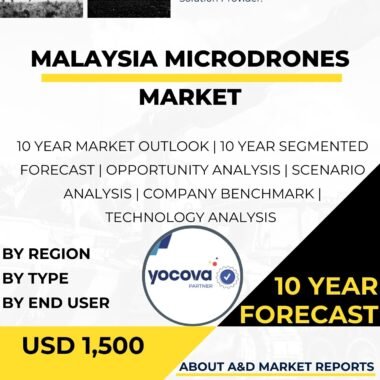Description
United Kingdom Microdrones Market Overview
The United Kingdom microdrones market is a rapidly growing sector that strengthens the country’s aerial surveillance, intelligence, and reconnaissance capabilities. Microdrones, or small unmanned aerial systems (sUAS), are miniature drones with advanced sensors. They can operate in urban areas, confined spaces, and other locations where larger drones cannot. These micro-sized drones offer significant advantages for military, security, and civilian applications, including surveillance, disaster response, environmental monitoring, and infrastructure inspection.
Development of Advanced Microdrones
The UK microdrones market focuses on designing and producing advanced micro-sized drone platforms. The government and private companies invest in drones that meet the operational needs of the armed forces, law enforcement agencies, emergency responders, and civilian sectors. The goal is to create drones that are reliable, adaptable, and capable of performing in complex environments.
Applications in Intelligence and Surveillance
Microdrones play a key role in intelligence, surveillance, and reconnaissance (ISR) missions. Equipped with high-resolution cameras, infrared sensors, LiDAR, and gas detectors, they provide real-time data for monitoring disaster zones, criminal activity, environmental conditions, and military operations. The UK microdrones market ensures that operators can access critical information quickly and covertly.
Integration of Advanced Technologies
Modern microdrones integrate state-of-the-art avionics, communication systems, and data processing tools. The UK defense microdrones market provides military and security forces with the capability to conduct effective surveillance and respond to diverse operational challenges. These drones are versatile, quickly deployable, and suitable for reconnaissance in urban and hard-to-reach areas.
Role in Counterterrorism and Security Operations
Microdrones enhance counterterrorism and security operations. They help detect threats, monitor areas of interest, and support law enforcement and military missions. The United Kingdom microdrones market focuses on drones that are flexible, reliable, and effective in sensitive operations.
Innovation and Research
The UK microdrones market is driven by continuous research and development. Engineers and scientists work to improve performance, endurance, sensor capabilities, and operational flexibility. Ongoing innovation ensures microdrones remain effective against emerging threats.
Training and Human Factors
Operating microdrones requires trained personnel. Operators must understand drone capabilities, limitations, and safe usage protocols. Training programs in the UK microdrones market ensure that both military and civilian personnel can use drones safely and effectively.
Challenges in the Microdrones Market
The UK microdrones market faces several challenges. Continuous investment in R&D is needed to stay ahead of technological threats and countermeasures. Cybersecurity is also a concern, as interconnected drones are vulnerable to hacking. Regulatory compliance and airspace management are crucial to avoid risks to other aircraft and the public.
Conclusion
The United Kingdom microdrones market is a dynamic sector supporting aerial surveillance, intelligence, and reconnaissance capabilities. Microdrones offer advantages in covert operations, search and rescue, and monitoring missions for military and civilian applications. Continuous innovation, training, and technology integration ensure microdrones remain a key asset in enhancing the UK’s defense and security capabilities.




